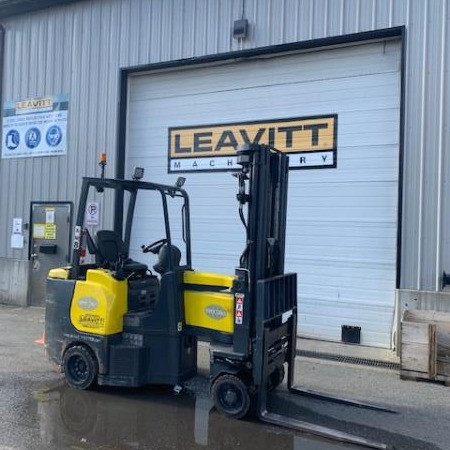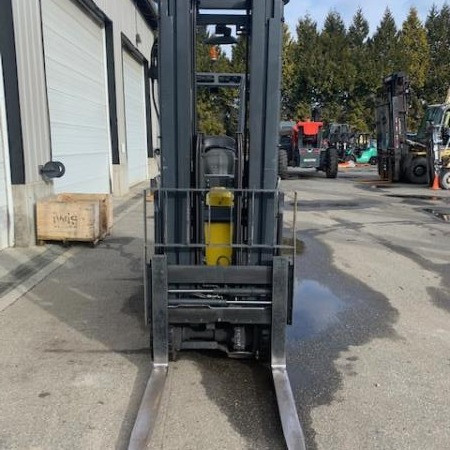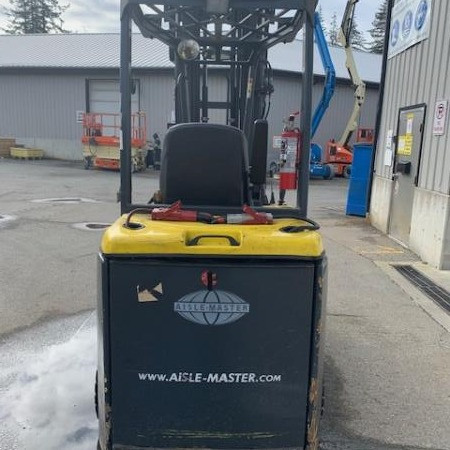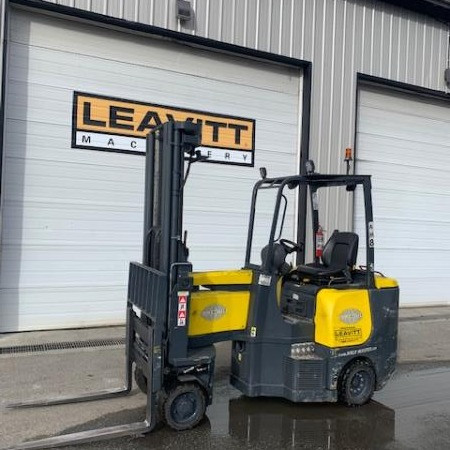Very Narrow Aisle Forklift San Francisco
Used Very Narrow Aisle Forklift San Francisco - Getting items from one warehouse location to another and to and from the loading docks is the focus of warehousing. Focus is often on space saving tools and the layout of the building. Very narrow aisle solutions allow for more space to be dedicated to the storage of goods because less space is required for aisle access. Configuring the warehouse is known as warehouse optimization.
Warehouse Optimization
Several benefits can be enjoyed for adding very narrow aisle warehouse optimization such as more storage space for the facility.
Using narrow forklift trucks instead of traditional forklifts can enable the warehouse width of the aisles can be lessened to half. Many very narrow aisle forklifts offer greater stack height capability which further increases the storage capacity per square foot. Very narrow aisle forklifts can greatly reduce costs compared to traditional forklifts since the same amount of stock takes up less space in the warehouse. In most urban areas where square footage is very costly, this is a huge benefit to warehouse operations. Warehouse storage can be increased up to eighty percent with careful planning when a narrow aisle width configuration is utilized. This warehouse design creates more rack faces and increased product access. Reduced travel time for storing items and gathering products are some of the key benefits to this warehouse layout as more products are found in an accessible location.
Very narrow aisle layouts and narrow aisle layouts are popular for warehouses. Narrow aisles are usually those that use less than 11 feet of aisle width. Very narrow aisles reduce the aisle width further to around six-and-a-half feet. Either of these widths drastically increases storage potential. However, they also create challenges when turning within the aisles using forklifts for stocking and order picking. These challenges are met by using very narrow forklifts to gain access and complete tasks.
Before choosing a forklift for a particular job, it is vital to know the dimensions of the aisle. It is important to have the correct aisle dimensions before forklift shopping to avoid securing a machine that won’t fit its’ intended location. Finally, it is critical that any utilities, posts or columns are taken into account before settling on a specific narrow aisle forklift design as these may affect access to aisles by some forklifts or prevent warehouse optimization.
Very Narrow Aisle Forklift Trucks
Rechargeable batteries are typical for powering very narrow aisle forklift trucks and most models are electric. Stand-up riders are a popular design for very narrow aisle forklift trucks. The most popular kinds of very narrow aisle forklift trucks include turret or swing-mast, end-control riders, order pickers and reach trucks.
Reach Forklift Trucks
The reach trucks were created as a type of rider stacker forklift but can be modified specifically for narrow aisle usage. The reach trucks developed their name from their forward-reaching actions to get a load. The two kinds of reach trucks the moving carriage and the moving mast. The moving carriage works by raising and lowering the carriage, along with the operator. While the operator stays at ground level, the moving mast is responsible for raising and lowering the forks. The moving mast reach truck is generally considered the safer of the two types of reach trucks. Reach trucks utilize a pantograph system that is a jointed framework design enabling the driver to place and reach loads without moving the forklift.
Order Pickers
Order pickers were created to specifically pick orders from difficult-to-access racks. Order pickers are specific for lighter stock items that can be lifted by hand. They lift the operator up to reach the goods by identifying and choosing certain items to create an order.
End-Control Riders
End-control riders are machines that pick loads up at floor level and move the items horizontally as opposed to lowering or lifting over numerous heights.
Turret or Swing-Mast Forklift
Swing-mast or turret very narrow aisle forklifts feature an articulating swivel mast that pivots. The mast swivels to enable pallets to be positioned on the right or left side of the forklift.
Guided Very Narrow Aisle Trucks
Many very narrow aisle forklift trucks are able to be guided down aisles by wire or rail.
Thanks to the guide rails, the possibility of crashing into racks is greatly reduced. Rail-guided applications use special rails set into the floor on either side of the aisle, funning the length of the location and curving around the edge. Specific wheel guides are on the forklift. These slide into the rails to stop the forklift from moving out of the rail guards.
Wire-guidance forklift systems install wires on the floor instead of rails and the wires run down the middle of the aisle. The wire-guides function similarly to the rail systems except the forklift has a wire-guide system to prevent the machine from traveling where it is not supposed to.
Work Site Considerations
Certain essential considerations need to be dealt with before using a narrow aisle configuration. The narrow aisle units feature tall racking systems. The floor construction and the racks need to be carefully taken into account for everyone’s safety. There are four main locations that need to be ideally prepared before any racking system can be installed. These areas need to be monitored continuously including fixing cracks in the floor, ensuring the racks are straight, a level floor and an appropriate load capacity of the floor.
Level Floor
Because of the height of the racking systems, any slight slope of the floor is likely to negatively affect the plumbness of the racks, especially over time when loads are continuously placed and removed on the racks. A level floor is vital for the safety and integrity of the operator, employees, stock and the warehouse.
Crack Repair
When there are floor cracks found, they need to be assessed and immediately fixed for safety concerns. Safety can become compromised when flooring cracks become 3/8 inches wide. They require proper filling with a substance that is as hard as the floor.
Floor Load Capacity
The floor needs to meet specific minimum requirements prior to a narrow aisle configuration. At a minimum, the floor should consist of 3,000 psi concrete as well as contain evenly distributed rebar approximately 3 to 4 inches below the surface. Extra reinforcements might be needed depending on the load requirements and the configuration.
Plumb Racks
Installing the racks safely and correctly is vital for the entire system. If installed improperly, there is a great chance of rack failure. Every rack needs to be plumb to ensure a safe system and work environment. Rack shims can help the rack stay plumb to one inch at the height of thirty feet.
If the above measures are not taken or are improperly implemented, it is likely to cause a racking failure. Such failure is likely to result in costly damage to goods, the warehouse facility, forklifts and, worst of all, employees could be significantly injured or even killed. Due to these potential problems, the most significant part of creating a narrow aisle configuration for warehousing optimization is the initial measurements.
Very Narrow Aisle Forklift PDF
Stock Number: 207213 GL
Make: AISLEMASTER
Model: 44E
Year: 2013
| Stock Number |
207213 GL |
| Make |
AISLEMASTER |
| Model |
44E |
| Year |
2013 |
| Category |
Very Narrow Aisle Forklift |
Stock Number: 208758 GL
Make: AISLEMASTER
Model: 44SE
Year: 2015
| Stock Number |
208758 GL |
| Make |
AISLEMASTER |
| Model |
44SE |
| Year |
2015 |
| Category |
Very Narrow Aisle Forklift |
Stock Number: 209213 GL
Make: AISLEMASTER
Model: 44SE
Year: 2015
| Stock Number |
209213 GL |
| Make |
AISLEMASTER |
| Model |
44SE |
| Year |
2015 |
| Category |
Very Narrow Aisle Forklift |













